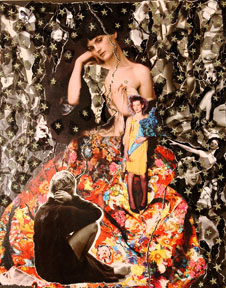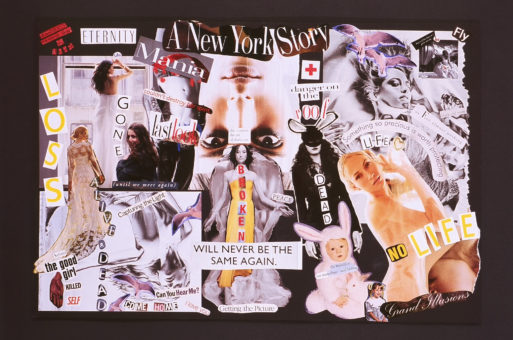Today is the second part of a two-part interview with Sharon Strouse, a Maryland-based board-certified registered art therapist and licensed clinical professional art therapist. Sharon lost her daughter Kristin to suicide in 2001, and has since worked as a bereavement specialist and presenter, telling her story at various suicide-related workshops throughout the United States. She is a board member of the Johns Hopkins Medicine Department of Psychiatry and Behavioral Sciences, and the author of “Artful Grief: A Diary of Healing,” published in 2013.

Collage “Once Upon a Time” created February 2003
Angela Underwood: Are there fewer rules to art therapy than writing therapy?
Sharon Strouse: Any kind of trauma goes beneath words. There is no language for that kind of suffering in the body. That is why images are important because all of that kind of work is preverbal. You can’t put words on it, and art helps to unlock that.
You even go deeper when you work with images in a creative way. I had done years of collage work before writing my book, “Artful Grief: A Diary of Healing.” Touching into that moment of Kristen’s death over and over again until I could be released from it. All of that is non-verbal.
The collages also helped me to write about it years later in a way that wasn’t retraumatizing. I see a lot of survivors who want to tell their story and try to do so much too soon. They haven’t done the underlying work around it. It was really vital to me that I was able to go to those really deep places creatively. So when I wrote the book, it was just flowing through me in a really beautiful and peaceful way. It is an interesting process.
Angela: Can making collages and art therapy help heal other losses in your life?
Sharon: We lose ourselves through all kinds of life situations. There are so many things that happen to us, and the creative process works across the board. When I work with people, I start with a meditative process — a grounding and quieting, so people can learn to come into their body and be in touch with what is here now and not what they think is here. Usually their body will respond.
 You don’t have to have an idea about what you like or don’t like, just the response to the image. Then you put it together, and ask, “What is this about, today, for me?” I love not giving directives to people. It is very open ended.
You don’t have to have an idea about what you like or don’t like, just the response to the image. Then you put it together, and ask, “What is this about, today, for me?” I love not giving directives to people. It is very open ended.
So to answer your question, I work with all kinds of loss, not just suicide. It can be other kinds of trauma than death, too. It could be a car accident that caused something to happen to your body, or just working through the shock or trauma of something like that.
Angela: Can you use particular magazines that remind you of the loved one you lost?
Sharon: Use your intuition. Surround yourself with magazines that will be poignant. Then just sit with the intention. I always make my work sacred because it is. I think all of our feelings are sacred.
When I create a collage, I follow a certain ritual. I gather my materials; light a candle, take a few deep breaths; and open to what is there.
Just be curious and open to what comes through. As you open the magazines and start to look, it will reveal itself. Ask yourself, “In what way does this event in your life connect to other losses?” Or “Does it connect to core wounds or central issues in your life and other grief experiences?” Grief and loss are things that bind everybody — the entire human race. We are all suffering losses of some sort or another. Let yourself be curious, gather the materials and sit with the intention for healing to happen. The most important thing is showing up and giving yourself the time to do it. Once you create the time, all you need to do is be present and show up.

Grand Illusions: Created 2003
Angela: Did starting the Kristin Rita Strouse Foundation also help you move through your grief over your daughter’s suicide?
Sharon: Creating the foundation was what came out of the confusion of the first year. We thought of taking scholarship money to donate and giving it to art students. But how would that address the issues of mental illness and the reasons why Kristen decided to take her own life and make an impact on that? So we worked with John’s Hopkins to develop the Adolescent Depression Awareness Program, which provides outreach and education to high schools, educators, parents and adolescents about depression. That was 17 years ago and we have raised approximately $1.5 million dollars for the program thus far.
Angela: Can you offer our readers some tips about how to approach collage making as a tool for moving through grief and loss?
Sharon: Sure. Here are a few tips I offer in “Artful Grief: A Diary of Healing:”
- Create a safe place with some magazines you love
- Use scissors rather than tearing out the images
- Have glue handy. I like to use a glue stick
- Gather your materials for mounting your collage
- Adopt a “you-cannot-go-wrong” attitude
- Take a moment to meditate before you begin
- Have fun
Did you miss the first part of our interview with Sharon? If so, catch up and read part one now.

 How Can Creating a Collage Help Heal the Loss of a Loved One?
How Can Creating a Collage Help Heal the Loss of a Loved One?


 “In Case You Don’t Live Forever” by Ben Platt
“In Case You Don’t Live Forever” by Ben Platt
 Our Monthly Tip: Make an “In Case of Death” File to Ease Loved One’s Grief
Our Monthly Tip: Make an “In Case of Death” File to Ease Loved One’s Grief
 Passing of Beloved Comedian Births a New Comedy Festival
Passing of Beloved Comedian Births a New Comedy Festival














